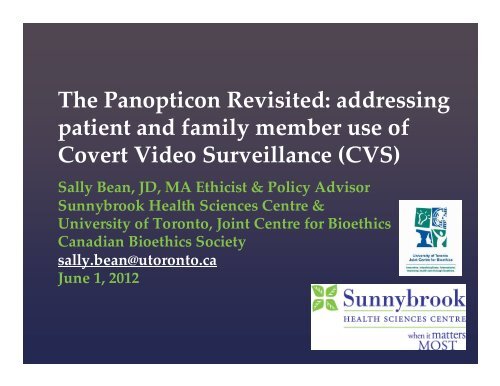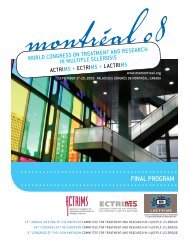Create successful ePaper yourself
Turn your PDF publications into a flip-book with our unique Google optimized e-Paper software.
The Panopticon Revisited: addressing<br />
patient and family member use of<br />
Covert Video Surveillance (<strong>CVS</strong>)<br />
Sally Bean, JD, MA Ethicist & Policy Advisor<br />
Sunnybrook Health Sciences Centre &<br />
University of Toronto, Joint Centre for Bioethics<br />
Canadian Bioethics Society<br />
sally.bean@utoronto.ca<br />
June 1, 2012
Roadmap:<br />
Introduction<br />
Introduction<br />
Definition<br />
Illustrative cases<br />
Stakeholder perspectives<br />
Ethical issues<br />
Relevant law<br />
Managing <strong>CVS</strong> Situations<br />
Potential organizational response(s)<br />
Management plans<br />
Summary
The Panopticon
Definition<br />
Covert Video Surveillance (<strong>CVS</strong>):<br />
Term coined for situations of suspected child abuse to<br />
characterize recording interactions between child and<br />
parent/guardian without the knowledge of the<br />
parent/guardian (Shabde & Craft 1999)<br />
<strong>CVS</strong> used to monitor parent guardian suspected of<br />
Munchausen by proxy or healthcare providers under<br />
suspicion of elder abuse. (Shabde & Craft 1999; Toben<br />
& Cordon 2010)<br />
Also referred to as “surreptitious surreptitious recording” recording or<br />
“electric electric monitoring”<br />
monitoring
Illustrative Cases<br />
Substitute Decision Maker (SDM) believes that staff are<br />
not checking in on <strong>inc</strong>apable patient throughout the<br />
night.<br />
SDM Purchases clock radio that can capture audio and<br />
video onto a memory card and positions it on patient’s patient s<br />
bedside table so the door and anyone exiting or entering is<br />
visible.<br />
Later complains to nurse manager and contends can<br />
“prove prove” allegations.<br />
Patient surreptitiously uses phone with web cam to<br />
document nurse-patient nurse patient interactions to demonstrate<br />
quality of care concerns such as response times to call<br />
bell.
Key Issues/Questions:<br />
Should we deter surreptitious recording of staff members by<br />
patients & families?<br />
What policies and/or change management approaches will we<br />
implement?<br />
How should we address these situations after they arise, arise,<br />
i.e.<br />
what will be associated repercussions or management?<br />
S<strong>inc</strong>e this is not a legally prohibited/sanctioned activity, there there<br />
is<br />
limited recourse<br />
What is our duty/obligation to staff members to disclose<br />
surreptitious recording?<br />
How can we rebuild impaired trust relationships with patients<br />
and families?
Deterring <strong>CVS</strong>?<br />
Most hospital ‘Consent Consent to Recording’ Recording policies pertain<br />
to overt recording, e.g. recording the birth of a child,<br />
taking a picture of a trusted healthcare provider and<br />
taking pictures of patients/family for hospital<br />
advertisements, brochures, media, etc.<br />
To date, most policies simply note that express written<br />
consent from staff is required for recording (and do not<br />
differentiate between overt and covert recording)<br />
Will explicitly broaching the subject matter of covert<br />
recording through signage, prohibition via policy, etc.<br />
have the opposite effect, i.e. encourage <strong>CVS</strong> activities?
Stakeholder Perspectives:<br />
{ {<br />
Patient & Family Perspective<br />
Means to equalize power<br />
imbalance<br />
Creates evidence to<br />
substantiate quality of<br />
care concerns<br />
Staff should have<br />
“nothing nothing to hide” hide in<br />
course of work duties<br />
Staff are public<br />
employees in public<br />
hospital<br />
Promoting patient’s patient s<br />
safety outweighs staff’s staff s<br />
privacy concerns<br />
Employee & Org Perspective<br />
No informed consent so staff<br />
autonomy and org’s org s ability to<br />
control flow of information is<br />
undermined<br />
Potential harm to employees?<br />
Obligation to disclose to<br />
affected employees?<br />
Individual &/or organization<br />
could be negatively depicted<br />
in public eye Should standard<br />
vary in residential areas, e.g.<br />
long-term long term care home?<br />
Public hospital can enforce its<br />
own policies, e.g. parking,<br />
smoking bans, etc.
Ethical Issues<br />
Indication of impaired therapeutic trust relationship<br />
Without express consent, autonomy of HCPs is<br />
undermines<br />
Vulnerability of <strong>inc</strong>apable patients that cannot consent to<br />
having their privacy limited/infringed<br />
Fair and proportionate org response(s) to <strong>CVS</strong><br />
Duty/obligation to disclose <strong>CVS</strong> activities to staff
Privacy Tort Law Background<br />
Roots of privacy tort first articulated in 1890 by Warren &<br />
Brandeis<br />
Argued for creation of new right protecting an individual’s individual s personal<br />
space from unnecessary and unauthorized public disclosure (and<br />
thereby provide redress for infringement); (Abril 2007)<br />
In 1960, Prosser categorized privacy law into four dist<strong>inc</strong>t torts torts<br />
which was adopted in the 2 nd Restatement of Torts:<br />
**Invasion of privacy by intrusion**<br />
Public disclosure of private facts<br />
False light<br />
Appropriation<br />
(Prosser 1960)<br />
Appropriation
Privacy Tort Law Background<br />
To make a case for invasion of privacy by intrusion, a<br />
plaintiff must show:<br />
1. an unauthorized intrusion;<br />
2. that the intrusion was highly offensive to a reasonable<br />
person;<br />
3. the matter intruded upon was private; and,<br />
4. the intrusion caused anguish and suffering.<br />
2 nd Restatement of Torts (2010)
Canadian Law<br />
Personal Information Protection and Electronic Documents Act<br />
(PIPEDA-federal); (PIPEDA federal); Personal Health Information Protection Act<br />
(PHIPA ) & Freedom of Information and Protection of Privacy Act<br />
(FIPPA) (Prov<strong>inc</strong>ial-Ontario):<br />
(Prov<strong>inc</strong>ial Ontario):<br />
none applies to private rights of action between individuals<br />
The SCC has consistently interpreted the Charter’s Charter s s. 8 protection<br />
against unreasonable search and seizure as protecting the underlying underlying<br />
right to privacy.<br />
Privacy Tort Law is developing in Canada:<br />
For example, in Jan 2012, Ontario COA recognized a right to bring bring<br />
a civil<br />
action for invasion of personal privacy (Jones v. Tsige)<br />
In Jones v. Tsige, ex-wife ex wife working at a bank inappropriately accessed the<br />
account records of her ex-husband<br />
ex husband’s s new partner<br />
4 common law prov<strong>inc</strong>es have statutorily created tort of invasion of<br />
privacy:<br />
B.C., Manitoba, Saskatchewan & Newfoundland; Civil Code of Quebe Quebec c explicitly<br />
protects right to privacy<br />
No Prov<strong>inc</strong>ial privacy legislation precisely defines what constit constitutes utes an invasion of<br />
privacy
US Judicial Assessment of Privacy Breaches<br />
Two key factors figure prominently in assessing breach of privacy privacy<br />
cases:<br />
1. Where the privacy invasion occurred (i.e. in a public versus private<br />
location) AND<br />
2. Who perpetrated the privacy invasion (i.e. government actor or or<br />
member of public);(Abril 2007)<br />
To help differentiate between public versus private locations, US<br />
courts ask whether there was a reasonable expectation of privacy<br />
in the location where the alleged breach occurred?<br />
However, this means that our rights change when technology does<br />
(Friedman 2012)<br />
In US. V. Jones (2012) USSC Justice Sotomayor noted that the court court’s<br />
s<br />
longstanding reliance on expectations of privacy are “ill ill-suited suited to the<br />
digital age” age (Friedman 2012)
Potential Organizational Responses:<br />
Corporate Policy prohibiting filming/ recording of staff without<br />
consent<br />
Possible responses to infractions:<br />
Punitive measures such as supervised visitation<br />
View it as a sign of impaired trust and approach in a restorativ restorative e manner, i.e.<br />
how can we win back your trust?<br />
AND/OR<br />
Could potentially require escalation or consult with patient rel relations, ations, for<br />
example<br />
“Universal Universal Precautions”/ Precautions / Transparency Approach<br />
Orient staff that cannot ensure that patient/family filming will not occur<br />
in course of professional duties so assume it will occur
Managing <strong>CVS</strong> Situations<br />
Reasonable Responses to <strong>CVS</strong>?<br />
When situations have been encountered, found that there has been a<br />
punitive overreaction, e.g. limited visitation, required chaperoned<br />
chaperoned<br />
visitation, etc.<br />
However, isolation due to restricted visitation could have unint unintended ended<br />
negative consequences on a patient patient’s s well well-being being<br />
If unapproved equipment is put into place (the clock radio example) example)<br />
can be removed due to potential interference with medical devices devices<br />
but have no legal grounds to keep property so must be relinquished<br />
relinquished<br />
to owner
Managing <strong>CVS</strong> Situations<br />
Duty to Disclose to Employees?<br />
HR noted, if camera not removed, employees who are at risk from<br />
having their activity caught by the camera should be told that the the<br />
camera is there.<br />
There should also be some communication to them as to why the<br />
camera is being allowed.<br />
However, the question remains that if the hospital does require<br />
removal of the camera, is there an ethical obligation to inform staff<br />
who may have been recorded?
Managing <strong>CVS</strong> Situations:<br />
How should managers respond when they are provided<br />
with recordings from <strong>CVS</strong>?<br />
Condone activity if watch the recording but could be an<br />
opportunity to learn about inappropriate employee conduct… conduct<br />
As an organization, we decided to informally decline to<br />
watch the recording but ask that patient/family describe<br />
what activity occurred and discuss associated concerns
Summary<br />
No applicable legislation or common law to address<br />
surreptitious recording of staff in course of their<br />
professional duties.<br />
While we can prohibit the activity via hospital policy,<br />
enforcing penalties, repercussions, etc. is challenging<br />
and should (ideally) be a proportional response.<br />
As part of change management, may want to<br />
consider a “universal universal precautions” precautions or transparency<br />
approach in which staff are cautioned that while <strong>CVS</strong><br />
is discouraged/prohibited, it may/will occur
Works Cited:<br />
Toben B. Cordon M. Legislative Stasis: The Failures of Legislation Legislati on and<br />
Legislative Proposals Permitting the Use of Electronic Monitoring<br />
Monitoring<br />
Devices in Nursing Homes. Baylor Law Review 2010; 59(3): 675-734. 675 734.<br />
Shabde N. Craft A. Covert video surveillance: an important<br />
investigative tool or a breach of trust? Arch Dis Child 1999;81:291-294<br />
1999;81:291 294<br />
Swire P. Bermann S. Information Privacy: Official Reference for the<br />
Certified Information Privacy<br />
Professional. (2007) International Association of Privacy Professionals<br />
Professionals<br />
Publication.<br />
Jones v. Tsige. Tsige.<br />
2012 ONCA 32.<br />
Abril P.S. Recasting Privacy Torts in a Spaceless World. Harvard<br />
Journal of Law & Technology. 2007; 21(1): 1-47. 1 47.<br />
Friedman B. Privacy, Technology & Law. The New York Times. Times.<br />
Jan. 28,<br />
2012.<br />
Prosser D. Privacy, 48 Cal L. Rev. 383, 389 (1960).
Questions?<br />
E-mail: sally.bean@utoronto.ca<br />
*Special Thanks to Maria McDonald*



